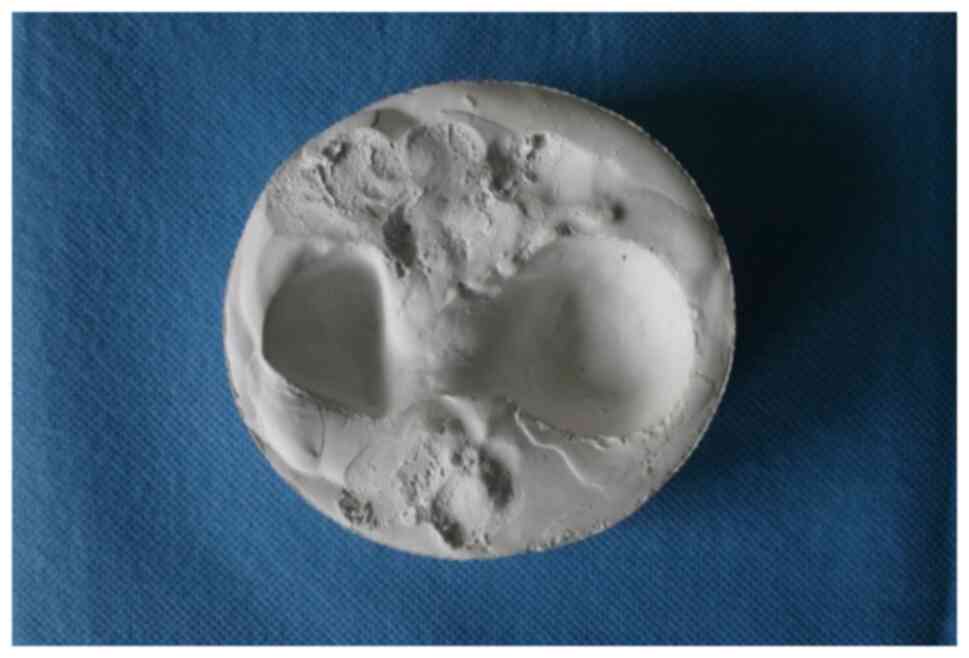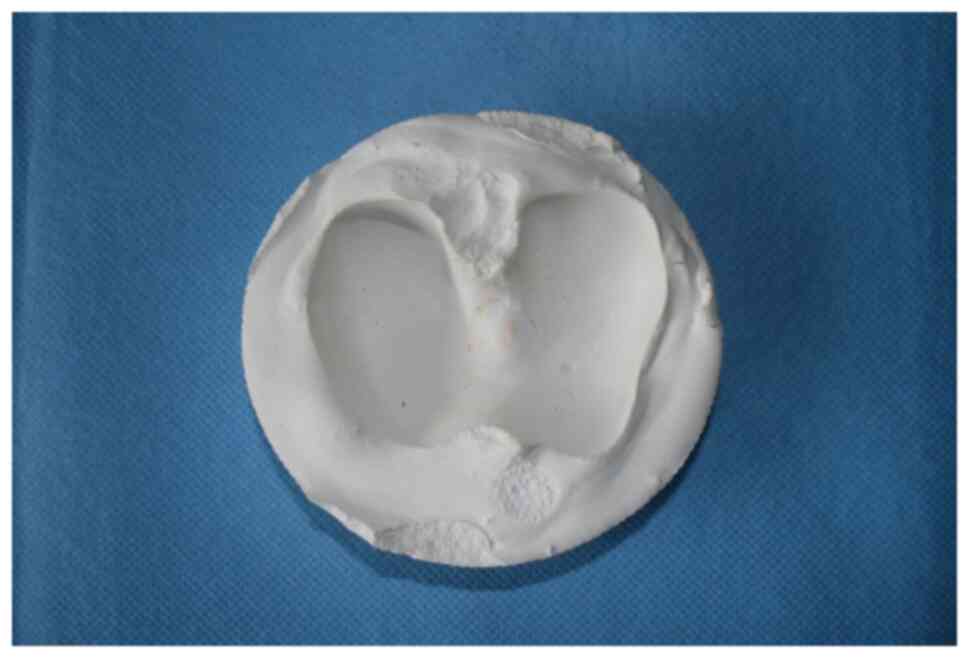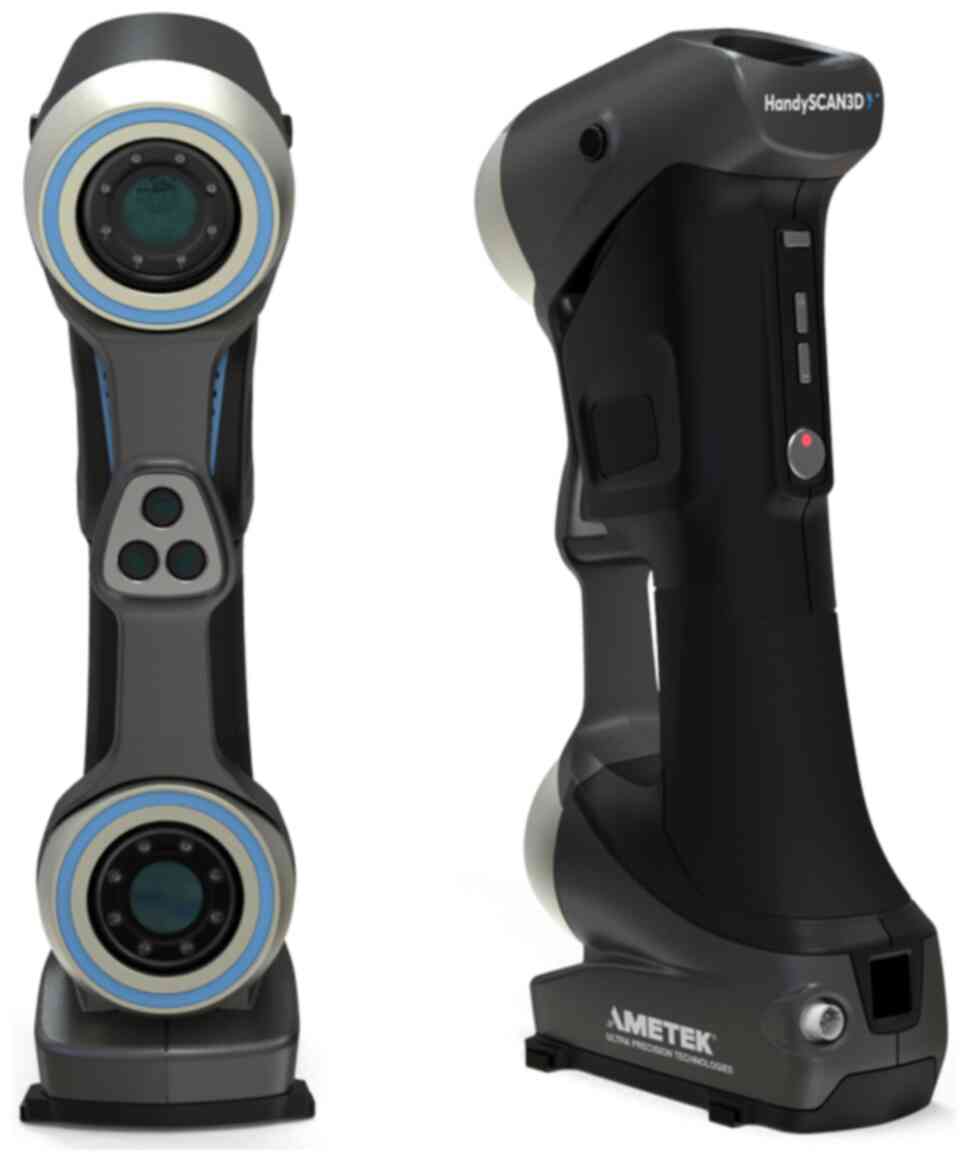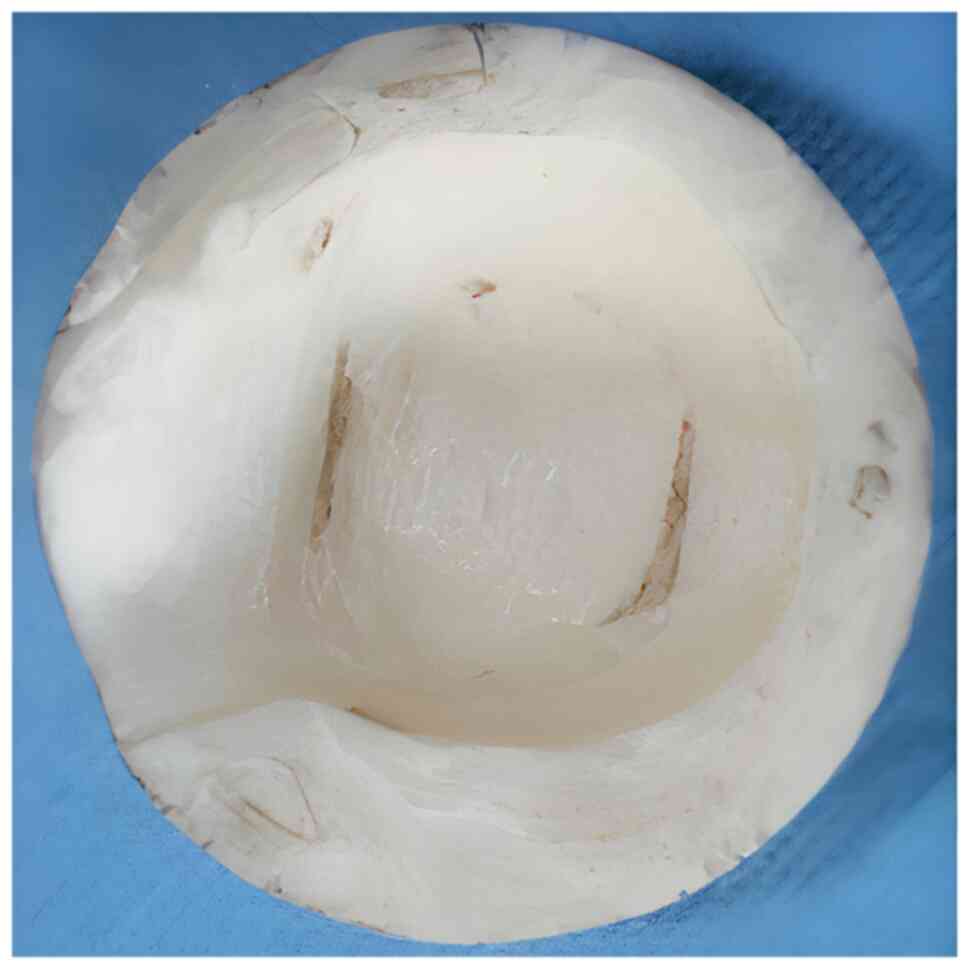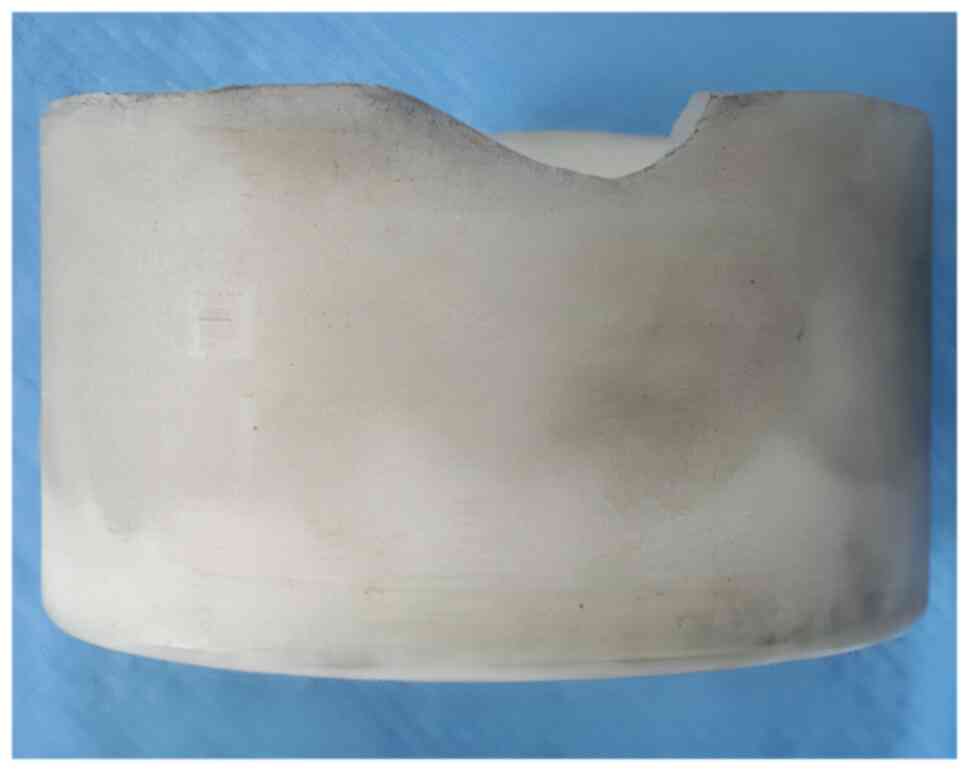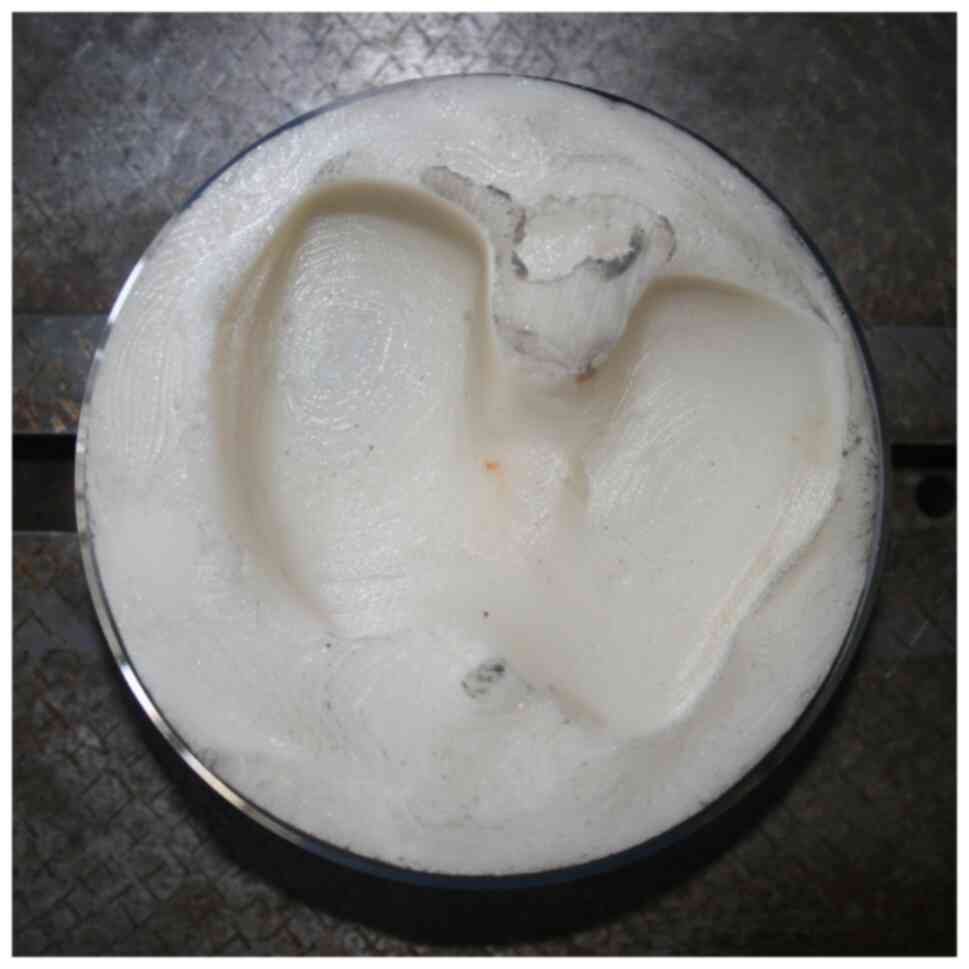An original method of simulating the articular cartilage in the context of in vitro biomechanical studies investigating the proximal femur
- Authors:
- Published online on: January 5, 2022 https://doi.org/10.3892/etm.2022.11125
- Article Number: 202
-
Copyright: © Gheorghevici et al. This is an open access article distributed under the terms of Creative Commons Attribution License.
Abstract
Introduction
Despite the development of novel implants based on biomechanical principles, the mechanical complications of osteosynthesis exhibit high rates of 1-32% (1-8). In order to optimize the surgical treatment and the implant used, biomechanical testing remains the gold standard. There is a multitude of biomechanical studies on the osteosynthesis of proximal femoral fractures, performed on both cadaveric and composite bone, in different loading modes, with heterogeneous results (1-7,9,10). Although cadaveric bone has long been considered a ‘gold standard’ for biomechanical testing (3,11), composite bone is an increasingly used alternative (9).
Knowing the area of contact of the hip joint and the distribution of pressure during daily activities is important in predicting the mechanism of mechanical complications after osteosynthesis, providing biomechanical reasons for preoperative planning and postoperative rehabilitation (12). While walking, the pressure on the femoral head is not constant or evenly distributed. Yoshida et al (12) stated that during walking, the peak pressure is located on the side roof of the acetabulum. During standing and sitting and while bending the knees, the peak pressures are located at the edge of the posterior horn (12). When climbing the stairs, the maximum pressure is found on the side roof, and this is higher than that when going down the stairs (12). Most studies (2-6,9,10) perform the loading directly on the femoral head or through a metal piece that concentrates the force on a limited area of the head, thus not respecting the hip joint contact area (2,9,10). The present study was performed to generate loading/unloading cups similar to the human acetabulum with similar biomechanical properties compared with the hip cartilage using additive technology in order to simulate the in vivo conditions while walking.
Materials and methods
Materials
After a comparative analysis of the materials compatible with the Stratasys FORTUS 250 mc machine, acrylonitrile butadiene styrene M30 (ABS-M30), a synthetic material with similar mechanical properties compared with the cartilage at the level of the adult hip (Table I), was selected (13). The characteristics of the ABS-M30 material were taken from the datasheet published by Stratasys, Ltd. The characteristics of the hip cartilage were taken from data reported in the literature (1). Acrylonitrile butadiene styrene (ABS) is a thermoplastic polymer of fossil source obtained through the polymerization of styrene and butadiene in the presence of acrylonitrile, which allows the manufacturing of models using additive manufacturing technology (14,15).
To simulate the articular cartilage at the level of the femoral head and condyles and to achieve a uniform distribution of the compression forces, the loading was carried out using two 3D-printed parts made on a Stratasys FORTUS 250 mc computer numerical control (CNC) machine (Stratasys, Ltd.) using ABS-M30 (Stratasys, Ltd.).
Methods
For biomechanical testing, forces between 208 and 1,400 N with frequencies between 0.2 and 1 Hz were used to simulate the normal gait of a 70 kg adult in vivo. The contact surface of the femoral head with the loading cup was 27.7 cm2. At maximum load (1,400 N), the force to be supported was 51.85 N/cm2, which was lower than the tension modulus of the ABS-M30 material (2.4x105 N/cm²), allowing its elastic deformation.
The loading/unloading cups were made through the impression of a Sawbones® (Pacific Research Laboratories, Inc.) femur model in casting gypsum (Figs. 1 and 2), which had been vacuum mixed for degasification. After the impression was performed and the casts were dried, the casts were painted for scanning using 3D Scan Spray (Helling GmbH).
These casts were then scanned using a 3D scanner, Creaform HandySCAN3D 300 (Ametek, Inc.) (Fig. 3), with a volumetric accuracy of 0.02 mm, obtaining 3D digital models in STL format using the Creaform VXelements 1 software (https://www.creaform3d.com/en/metrology-solutions/3d-applications-software-platforms/vxmodel-scan-cad-software-module; Fig. 4).
3D digital models in STL format were processed using Insight software (v15.9; Stratasys, Ltd.; Figs. 4 and 5).
Results
Fig. 6, Fig. 7 and Fig. 8 show models obtained after processing, with the CNC trajectories of the 3D printing head, in a thermally controlled atmosphere. The distance between the printed layers was 0.127 mm.
The loading/unloading cups designed in this manner simulated the acetabular cavity and the tibial plateaus anatomically and could represent a good technical solution in order to optimize the distribution of the loading/unloading forces in the context of biomechanical experiments
Discussion
Most studies have attempted the loading directly on the femoral head, thus failing to respect the in vivo model (2,9,10). Therefore, these studies (2-6,9,10) have opted for loading the femoral head using a metallic plate that shows limited contact with the femoral head. Other authors have used a cadaveric hemipelvis, which was prepared to be tested (7). In a biomechanical study on a cadaveric femur (1), the femoral head was loaded using a methyl polymethacrylate cup. Unlike the aforementioned studies (2-6,9,10), which attempted to load the femoral head by means of a rigid part with limited contact, Kane et al (8) understood the necessity of a uniform distribution of the mechanical stress at the level of the femoral head and used a urethane polymer (Smooth-Cast1 Urethane Series 300; Smooth-On, Inc.) to manufacture the loading cup. Although it ensures a uniform distribution of mechanical tension in the femoral head, the urethane polymer has properties similar to those of natural rubber and fails to transmit forces naturally (https://us.misumi-ec.com/maker/misumi/mech/product/ur/detail/detail.html).
The ABS material was used by Reddy et al (16) to design models of human bones using additive manufacturing technology. They used CT to scan various models of dry human bones and converted the resulting files into the STL format, which was used to reconstruct the digital model required for the 3D printing (16). Unlike Reddy et al (16), the present study used laser scanning to create the 3D model, which is a faster and less costly method.
It is well-known that, at the level of the femoral head, the articular cartilage exhibits a phenomenon of progressive degeneration following the loss of elasticity of the collagen fiber network (17). Research conducted by Kempson (17) and confirmed by Silver et al (18) has demonstrated that, at the level of the femoral head, the superficial layer of the cartilage exhibits a decrease in pressure resistance from 150 MPa at the age of 7 years to 80 MPa at the age of 90 years and from 60 MPa at the age of 7 years to 10 MPa at the age of 85 years. In a subsequent study, Silver et al (13) identified an elastic module of the articular cartilage at the level of the femoral head with values of 7.0 GPa at parallel stress and 2.21 GPa at perpendicular stress. In the present study, the ABS-M30 material used to design the loading cup exhibited an elasticity module of 2.4 GPa, which resembles the mechanical properties of adult hip cartilage.
3D printing is currently widely used in orthopedic practice, particularly for pre-surgery planning in arthroplasties and traumatology. Tack et al (14), in a systematic literature review published in 2016, which analyzed the utility of 3D printing in medical practice, identified 227 articles whose authors used additive manufacturing technology in the current practice. Tack et al (14) identified the advantages of this technique: reduction of surgical time, improvement of outcome and decrease of intra-surgery irradiation time. In the field of research of orthopedics, notable progress has been made regarding the mathematic modelling of the haversian structure of the bone in view of designing experimental models using additive manufacturing technology (15). Nevertheless, the authors of the present study admit that there are important limitations related to the printing material. Biomechanical studies simulating human cartilage using additive manufacturing technology were not identified in the literature. The selected material exhibits similar tensile strength and tensile modulus compared with the cartilage at the level of the adult human hip, thus mimicking the mechanical properties of adult hip cartilage.
In conclusion, manufacturing the loading cups from the ABS-M30 material using the method proposed in the present study allowed the realistic reproduction of the anatomy and the distribution of the forces at the level of the hip in in vitro biomechanical studies simulating walking.
Acknowledgements
Not applicable.
Funding
Funding: No funding was received.
Availability of data and materials
All data generated or analyzed during this study are included in this published article.
Authors' contributions
EC and TSG conceived the study. EC, TSG, PDS and BP developed the methodology. OA, AF and PDS performed formal analysis. AF, NF and MGP performed data curation. TSG and NF wrote the initial draft of the manuscript. EC and PDS confirm the authenticity of all the raw data. OA, BP EC and PDS revised the manuscript in light of the literature findings. All authors provided resources. All authors have read and approved the final manuscript.
Ethics approval and consent to participate
Not applicable.
Patient consent for publication
Not applicable.
Competing interests
The authors declare that they have no competing interests.
References
|
Wang J, Ma JX, Jia HB, Chen Y, Yang Y and Ma XL: Biomechanical evaluation of four methods for internal fixation of comminuted subtrochanteric fractures. Medicine (Baltimore). 95(e3382)2016.PubMed/NCBI View Article : Google Scholar | |
|
Schaefer TK, Spross C, Stoffel KK and Yates PJ: Biomechanical properties of a posterior fully threaded positioning screw for cannulated screw fixation of displaced neck of femur fractures. Injury. 46:2130–2133. 2015.PubMed/NCBI View Article : Google Scholar | |
|
Röderer G, Moll S, Gebhard F, Claes L and Krischak G: Side plate fixation vs. intramedullary nailing in an unstable medial femoral neck fracture model: A comparative biomechanical study. Clin Biomech (Bristol, Avon). 26:141–146. 2011.PubMed/NCBI View Article : Google Scholar | |
|
Windolf M, Braunstein V, Dutoit C and Schwieger K: Is a helical shaped implant a superior alternative to the Dynamic Hip Screw for unstable femoral neck fractures? A biomechanical investigation. Clin Biomech (Bristol, Avon). 24:59–64. 2009.PubMed/NCBI View Article : Google Scholar | |
|
Strauss E, Frank J, Lee J, Kummer FJ and Tejwani N: Helical blade versus sliding hip screw for treatment of unstable intertrochanteric hip fractures: A biomechanical evaluation. Injury. 37:984–989. 2006.PubMed/NCBI View Article : Google Scholar | |
|
Rosenblum SF, Zuckerman JD, Kummer FJ and Tam BS: A biomechanical evaluation of the Gamma nail. J Bone Joint Surg Br. 74:352–357. 1992.PubMed/NCBI View Article : Google Scholar | |
|
Santoni BG, Nayak AN, Cooper SA, Smithson IR, Cox JL, Marberry ST and Sanders RW: Comparison of femoral head rotation and varus collapse between a single lag screw and integrated dual screw intertrochanteric hip fracture fixation device using a cadaveric hemi-pelvis biomechanical model. J Orthop Trauma. 30:164–169. 2016.PubMed/NCBI View Article : Google Scholar | |
|
Kane P, Vopat B, Heard W, Thakur N, Paller D, Koruprolu S and Born C: Is tip apex distance as important as we think? A biomechanical study examining optimal lag screw placement. Clin Orthop Relat Res. 472:2492–2498. 2014.PubMed/NCBI View Article : Google Scholar | |
|
Basso T, Klaksvik J and Foss OA: Statistical consequences of using bone mineral density to pair cadaver femurs in comparative ex vivo hip fracture studies. Bone Joint Res. 3:317–320. 2014.PubMed/NCBI View Article : Google Scholar | |
|
Basso T, Klaksvik J, Syversen U and Foss OA: A biomechanical comparison of composite femurs and cadaver femurs used in experiments on operated hip fractures. J Biomech. 47:3898–3902. 2014.PubMed/NCBI View Article : Google Scholar | |
|
Deneka DA, Simonian PT, Stankewich CJ, Eckert D, Chapman JR and Tencer AF: Biomechanical comparison of internal fixation techniques for the treatment of unstable basicervical femoral neck fractures. J Orthop Trauma. 11:337–343. 1997.PubMed/NCBI View Article : Google Scholar | |
|
Yoshida H, Faust A, Wilckens J, Kitagawa M, Fetto J and Chao EY: Three-dimensional dynamic hip contact area and pressure distribution during activities of daily living. J Biomech. 39:1996–2004. 2006.PubMed/NCBI View Article : Google Scholar | |
|
Silver FH, Bradica G and Tria A: Elastic energy storage in human articular cartilage: Estimation of the elastic modulus for type II collagen and changes associated with osteoarthritis. Matrix Biol. 21:129–137. 2002.PubMed/NCBI View Article : Google Scholar | |
|
Tack P, Victor J, Gemmel P and Annemans L: 3D-printing techniques in a medical setting: A systematic literature review. Biomed Eng Online. 15(115)2016.PubMed/NCBI View Article : Google Scholar | |
|
Robles-Linares JA, Ramírez-Cedillo E, Siller HR, Rodríguez CA and Martínez-López JI: Parametric modeling of biomimetic cortical bone microstructure for additive manufacturing. Materials (Basel). 12(913)2019.PubMed/NCBI View Article : Google Scholar | |
|
Reddy MV, Eachempati K, Gurava Reddy AV and Mugalur A: Error analysis: How precise is fused deposition modeling in fabrication of bone models in comparison to the parent bones? Indian J Orthop. 52:196–201. 2018.PubMed/NCBI View Article : Google Scholar | |
|
Kempson GE: Age-related changes in the tensile properties of human articular cartilage: A comparative study between the femoral head of the hip joint and the talus of the ankle joint. Biochim Biophys Acta. 1075:223–230. 1991.PubMed/NCBI View Article : Google Scholar | |
|
Silver FH, Bradica G and Tria A: Relationship among biomechanical, biochemical, and cellular changes associated with osteoarthritis. Crit Rev Biomed Eng. 29:373–391. 2001.PubMed/NCBI View Article : Google Scholar |



